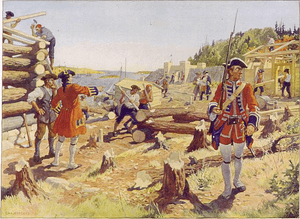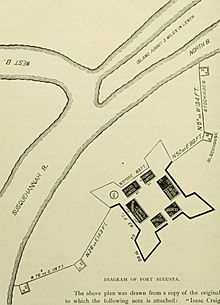William Clapham facts for kids
Quick facts for kids
William Clapham
|
|
|---|---|
| Born | 1722 Boston, Massachusetts |
| Died | 28 May 1763 (aged 40–41) West Newton, Pennsylvania |
| Years of service | 1747–1757 |
| Rank | Colonel |
| Unit | Clapham's Rangers, |
| Commands held | Fort Hunter, Fort Halifax, Fort Augusta |
| Battles/wars | Father Le Loutre's War, Battle at St. Croix, Battle at Chignecto, Raid on Dartmouth (1751) |
William Clapham (1722 – May 28, 1763) was an American military officer. He helped build several forts in Pennsylvania during the French and Indian War. People thought he was a good leader in battles against Native American warriors. Sadly, after he left the army, he and his family were killed on their farm in 1763.
Contents
Early Life
We don't know much about William Clapham's early life. He became a captain in Boston on November 1, 1747. He might have been born in Massachusetts. He was married to Mary Clapham.
Serving in Nova Scotia (1748–1754)
In 1748, Clapham was sent to Annapolis Royal to help defend it. He was a company commander there. He served with other soldiers from New England.
Clapham was in Nova Scotia during a conflict called Father Le Loutre's War (1749–1755). This was a fight between the British and the Mi'kmaq people and Acadians.
In August 1749, Captain Clapham was in charge at Canso, Nova Scotia. Some Mi'kmaq attacked Lieutenant Joseph Gorham and his group. They took twenty prisoners to Louisbourg. The British Governor, Edward Cornwallis, complained. The prisoners were then set free.
After an attack on Dartmouth in 1749, Clapham formed a group of 70 men. They were called "Clapham's Rangers." They were formed to fight the Mi'kmaq. Even though fighting continued, the Governor later ended most ranger groups.
Clapham helped in the Battle at St. Croix on March 23, 1750. He arrived with his rangers and two cannons. This made the Mi'kmaq leave. Clapham also fought in the Battle at Chignecto in September 1750.
During the 1751 attack on Dartmouth, Miꞌkmaq warriors and Acadian fighters attacked Dartmouth, Nova Scotia. They destroyed the town and killed many British villagers. Captain Clapham and his 60 rangers were at Blockhouse hill. They stayed inside their blockhouse and fired from small openings. A military court looked into why the village was destroyed.
Divorce in 1754
After serving in Nova Scotia, Clapham went back to Boston. He had to deal with a divorce. Records show that his marriage to Mary Clapham ended in 1754. This happened because William Clapham had left Mary for another woman. Mary was allowed to marry again. She also received her household furniture.
Becoming a Colonel in 1756
Clapham then moved to Pennsylvania. He helped Benjamin Franklin build forts along the frontier. In late 1755, Governor Robert Hunter Morris ordered new forts to be built. These forts would be protected by local soldiers. Plans were made for Fort Hunter, Fort Halifax, and Fort Augusta.
Clapham was promoted from captain to colonel in February 1756. He was put in charge of the Third Battalion, Pennsylvania Regiment of Foot. This group was also known as the Augusta Regiment. He also commanded defenses in Northampton County.
Fort Hunter

The Pennsylvania government decided to build a fort at Hunter's Mill. This was after the Penn's Creek massacre in October 1755. The mill was near the Susquehanna River. Fort Hunter was first a gristmill with a simple stockade around it. This happened in January 1756.
On March 8, 1756, Benjamin Franklin wrote about Clapham. He said that Colonel Clapham was a "very vigilant Gentleman." Franklin thought Clapham would help the soldiers get better at fighting in the woods.
On April 7, 1756, Governor Morris told Clapham to march his soldiers to Hunter's Mill. They were to start building the fort. The fort probably had a block house surrounded by a ditch. There was also a stockade. On May 11, 1756, Clapham took command of the fort. The town of Fort Hunter, Pennsylvania later grew near the fort.
Disagreement with Governor Morris
Clapham's personality caused some problems in May 1756. He and other officers stayed with Governor Robert Morris. The Governor said some things that upset Clapham. Clapham refused to speak to the governor for days. He even thought about leaving his troops. Other officers convinced him to stay. They helped the two men make up.
One historian said that Clapham was often criticized. He was from New England and seemed important. He sometimes acted without asking others. He also spoke without thinking. Because of this, some people thought he had risen higher than he should have.
Fort Halifax
On June 5, 1756, Clapham left Fort Hunter with five companies of soldiers. They marched north along the Susquehanna River. They were looking for a good place to build Fort Halifax. He chose a spot near many pine trees. He planned to use these trees for building. There was also a sawmill nearby.
On June 10, Clapham met with Oghaghradisha, an Iroquois chief. The chief gave Clapham a wampum belt. He also gave Clapham the Iroquois name "Ugcarumhiunth." The chief said the Iroquois agreed to the fort at Shamokin. But they also wanted a fort built further north in their land.
Fort Halifax was a stockade fort. It was 160 feet (49 m) square. It had four bastions and earth walls about 10 feet (3.0 m) high. Once it was finished, Pennsylvania soldiers guarded it. It was the main supply stop between settlements and Shamokin. Fort Augusta would be built at Shamokin later that summer. The fort was left empty in late 1757. It was taken apart in mid-1763.
Fort Augusta
In June 1756, Major James Burd finally got enough money and supplies. He started building Fort Augusta at the old Native American village of Shamokin. Colonel Clapham arrived in June with men and materials.
By mid-July, Clapham and his men were unhappy. The Commissary General, James Young, came to pay them. But much of their pay had been held back. Young wrote that Clapham was "highly displeased." Clapham even threatened to leave the army.
Clapham mostly finished Fort Augusta by late August 1756. It was the largest British fort built in Pennsylvania. It had earth walls over two hundred feet long. These walls had wooden defenses on top. Clapham worried that the French might attack the fort with cannons. He asked for more carpenters and supplies to make the walls stronger.
In the fall of 1756, a French raiding party saw Fort Augusta from a distance. They had three small cannons. But they left after deciding the fort was too strong.
The fort was guarded by sixteen officers and 337 men. It had twelve cannons and two swivel guns. It was the base for the Third Battalion, Pennsylvania Regiment of Foot. This group was formed to build and guard Fort Augusta.
On November 4, 1756, Colonel Clapham ordered an attack on Great Island (Lock Haven, Pennsylvania). He wanted to destroy the Native Americans there. They were thought to be helping the French. On December 8, Major James Burd took command of the fort.
Resignation in 1757
Clapham left his command of the fort in March 1757. He was not a very popular commander.
Pittsburgh Census in 1761
After helping build the forts, Clapham left the army. He moved to Pittsburgh in 1760. On April 14, 1761, Clapham published the first count of people in Pittsburgh. He did this for Colonel Henry Bouquet. He counted 104 houses. There were 332 people in total. This included 95 officers, soldiers, and their families. There were also 238 regular citizens.
Trading Post
Soon after, Clapham started a business with an Indian trader named George Croghan. They wanted to build a trading post and a settlement. This place was later called Oswegly Old Town.
In 1762, Clapham asked to settle on land south of Fort Pitt. He had bought this land from George Croghan. His request was approved. Clapham cleared his land in February 1763. He then ran a trading post and a large farm. This was where Sewickley Creek meets the Youghiogheny River. He and Croghan planned to sell food and animals to Fort Pitt.
Clapham was a well-known person in Pennsylvania. But unlike George Croghan, the tribes in the Ohio Valley did not trust him.
Death in 1763
Clapham's Trading Post was the first place attacked in Pennsylvania during Pontiac's War. On May 28, 1763, Keekyuscung, his son Wolf, and two other Native Americans reportedly killed William Clapham, his wife, and children. This happened at Clapham's farm on Sewickley Creek.
This was said to be revenge for Clapham ordering the destruction of a Lenape village in 1756. Wolf may also have wanted revenge because he was arrested at Fort Pitt in 1762. He had escaped and planned his revenge with his father. After the killings, a "war belt" was sent to other tribes. Soon, these tribes began to attack Fort Pitt.
On May 2, 1764, Colonel Henry Bouquet made demands to Native American tribes. He was negotiating for peace. He demanded that they hand over "the murderers of Clapham" to be punished.
William Clapham is buried in the cemetery at Trinity Cathedral in Pittsburgh.
In Popular Culture
There is a mention of "Captain Clapham" in an early version of the song Yankee Doodle. This version was printed sometime between 1748 and 1756.
The song says:
- Here's Father and I, for Canady,
- Likewise another Brother,
- And Seven more we leave on shore,
- For to take Care of Mother.
- Tho' I am young I do belong,
- To valiant Captain Clapham,
- I'll run my Chance and fight the French,
- And that’s the Way we’ll nab 'em.
Images for kids




